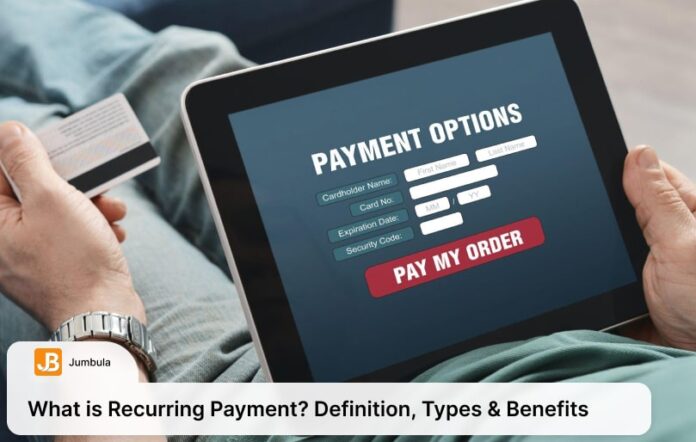In today’s dynamic business landscape, where convenience and stability reign supreme, recurring payment have emerged as a pivotal financial strategy that benefits both customers and businesses.
At its core, a recurring payment also referred to as installment billing, represents a seamless transaction model allowing customers to make regular payments at predetermined intervals.
Have you ever thought about implementing this technology into your business? Do you know what exactly the recurring payment is? And what are the benefits of it? In this article, we will cover all these topics.
This revolutionary concept, initially rooted in subscription services, has rapidly expanded its influence across various industries, offering unparalleled flexibility to customers while securing a steady income stream for businesses.
As we delve into the intricate world of recurring payments, it becomes evident that this mechanism not only transforms the way transactions occur but also plays a pivotal role in shaping financial strategies and customer experiences.
What is a recurring payment? Defining recurring billing and its types
A recurring payment, also known as installment billing, is a type of transaction that allows customers to make payments at regular intervals. This can allow more flexibility for the customer’s budget, and for businesses, it means reliable income flows.
The idea originated with subscription services, but today, most types of businesses utilize this form of payment in some way. Recurring payments can give customers an easy way to finance products and allow businesses to plan their cash flow effectively.
Generally, recurring payments have three distinct types:
- Automatically recurring payments (ARP) are made according to a predetermined timeframe.
- Payment schedules where the customers decide what time interval works best for them.
- On-demand recurring payments (ODRP) permit customers to access products or services as long as there is enough balance within the account.
These various payment options can enable individual consumers and business owners alike to enjoy many benefits, such as improved budgeting capabilities, more efficient tracking of expenses, increased customer loyalty, and, most importantly, a better overall experience when making purchases.
Benefits of setting up a recurring payment
Setting up a recurring payment has numerous benefits. It allows you to make scheduled payments, automate bill payments, and reduce the risks associated with manual payment processes.
In addition to making it easier to budget and manage expenses, recurring payments can help you stay organized by allowing you to track your payments in one place.

Furthermore, with recurring payments, there are fewer fees and late charges incurred as compared to manual payment methods. Being able to automate your bills saves time and effort, which can be put towards other important tasks.
Ultimately, establishing recurring payments is an excellent way to ensure that all of your bills are being paid on time and in a cost-effective manner.
Related Article: Benefits of Recurring Payments in the Modern World
Examples of using recurring payments in businesses
Recurring payments are becoming more popular with businesses of all kinds, as they offer a convenient way to automate and manage customer transactions.
For instance, subscription businesses such as Netflix and Spotify have successfully implemented recurring payment forms in their operations, allowing customers to avoid the hassle of renewing their subscription each time it ends.
Subscription boxes like Graze and Birchbox also make use of recurring payments to help keep things running smoothly.
Other businesses that utilize recurring payments include rental companies like Zipcar, software businesses like Adobe Creative Cloud, and online stores with frequent purchases, such as Amazon Pantry.
Each of these businesses has benefitted from the convenience offered by taking advantage of automated payment systems, ultimately saving customers time and businesses money.
How does recurring billing work?
Recurring billing is a system in which regular payments are automatically withdrawn from customers’ accounts on schedule. This allows companies to collect payments for ongoing services and services billed regularly, such as subscriptions or memberships.
Recurring billing is automated between the business and the customer’s bank. A proposed transaction is first sent to the issuing bank to check whether the customer’s account has sufficient funds before finally making an automated withdrawal if approved.
Recurring billing can be set up as one-off or recurrent payments with pre-defined time intervals; this payment method can save businesses time by avoiding manual invoicing efforts while providing greater control over cash flow.
Recurring billing also allows customers to have a better understanding of their finances by limiting the use of credit cards and organizing their budgeted spending over time.
Types of recurring payment
Different types of recurring payments can be used for different online transactions. Subscription-based services offer options to make these payments regularly. This could include subscription boxes, digital content, monthly services, etc.
Automated payment methods such as direct debit allow customers to pay bills in periodic installments and only have to manually initiate the process one time.
The different types of recurring payments also include pre-authorized debits and credit card-initiated payments on a regular schedule.
Regardless of the type of recurring payment you choose, you get the convenience and reliability of never having to worry about forgetting or being late with a payment.
The difference between recurring payment and subscription billing
Recurring payments and subscription billing have a lot of similarities, but they are not exactly the same.
Recurring payments are regularly scheduled payments made to a vendor or business for services and goods that are purchased periodically.

Subscription billing is when customers pay for products or services on a recurring basis for an extended period of time.
Recurring payments can be used as part of subscription billing; however, subscription billing typically involves a predetermined rate and pricing structure.
Additionally, automatic payment cycles associated with recurring payments can be different from those utilized in subscription billing, with customers paying as often as once per hour or yearly.
All in all, while related in nature, Recurring Payments and Subscription Billing have distinctions between them that should be considered when determining which payment method works best for a particular situation.
Recurring payment benefits
Recurring payments have become an essential component of many businesses’ transactions due to their numerous benefits.
Recurring payments allow users to arrange automatic debit or credit payments on a regular schedule, providing them with convenience, predictability, and flexibility in handling their finances.
This includes being able to easily adjust the amount and timing of payments, as well as having detailed records linked to their payment accounts that can be accessed at any time.
Recurring payments are also secure and efficient, reducing the amount of paperwork associated with keeping track of transactions while also eliminating the need for manual data entry when generating invoices and other documents.
All these features enable businesses to save time and money while streamlining their workflow processes.
Benefits of recurring payments – Increased enrollment
Recurring payments and billings offer a multitude of benefits that significantly contribute to the increased enrollment rates in various programs and services. One of the significant advantages is the enhanced convenience they provide to potential participants.
By spreading the financial commitment across smaller, regular payments, individuals find it easier to manage their budgets and are more likely to commit to enrolling.
Moreover, the automatic nature of recurring payments eliminates the need for manual renewal, ensuring continuity and uninterrupted access to the program or service.
Please check the article below to increase your enrollment:
How to Increase Enrollment in Preschool and Childcare Programs?
How to Increase Summer Camp Enrollment?
Recurring payment issues
Recurring payments are a great asset for any business, allowing them to streamline income with fewer charges and more reliability. Despite its many advantages, recurring payment issues can still arise from time to time.
These issues vary from mistakes in the payment system to data security risks and other problems that might stall a successful recurring payment system.
Depending on the type of recurring payment chosen by the business, it is possible for an individual to fall victim to fraud or scam.
It is important for businesses to be aware of these recurring payment issues and take proactive steps to tackle potential problems before they appear.
Taking these measures will ensure businesses have robust recurring payment processes that are secure, reliable, and successful in the long term.
Secrets to set up a recurring payment system for your business
If you’re looking to implement a recurring payment system for your business, there are a few tips you can follow to make it as streamlined and successful as possible.

Firstly, ensure you have the financial and customer data ready to accurately set up payments. Secondly, ensure that your customers understand why you’ve chosen to transition to a recurring payment system by informing them about the benefits.
Finally, monitor your recurring payment system regularly – this makes it easier to identify any potential issues during their early stages and take steps accordingly.
Related Article: Top 5 Best Recurring Billing Software
With these tips in mind, setting up a recurring payment system should be a hassle-free experience that allows your business transactions to run seamlessly.
Wrap up – Summary of recurring payment
In conclusion, the Jumbula platform offers an innovative solution that empowers businesses with the advantages of recurring payment, propelling them toward greater efficiency, convenience, and financial stability.
As we’ve explored throughout this blog post, recurring payments provide a strategic framework that not only benefits businesses but also enriches the customer experience.
With the diverse range of recurring billing options available – whether it’s automatically recurring payments, customizable schedules, or on-demand access – Jumbula caters to the unique needs of different industries and businesses.
By embracing the Jumbula platform, you’re not just adopting a payment system; you’re embracing a comprehensive tool that streamlines financial processes, mitigates risks, and enhances customer satisfaction.
In a world where seamless transactions and consistent cash flow are essential, Jumbula stands as a reliable partner in propelling your business toward a brighter future.
Start leveraging the power of recurring payment today and unlock a realm of possibilities for growth, organization, and financial success.

